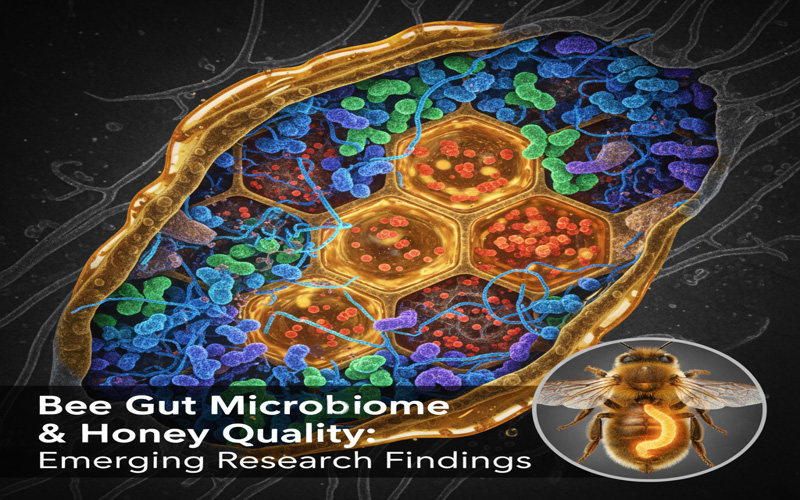- Tokyo: 21:38
- Singapore: 20:38
- Dubai: 16:38
- London: 12:38
- New York: 07:38
Bee Gut Microbiome & Honey Quality: Emerging Research Findings

In recent years, scientists have turned their attention to a fascinating and underexplored topic: the gut microbiome of honeybees. Much like humans, bees harbor a unique community of microorganisms in their digestive system that plays a crucial role in their overall health, digestion, and immunity. Beyond maintaining colony wellbeing, emerging evidence suggests that these gut microbes may also influence the quality, composition, and medicinal properties of honey. Understanding this relationship is becoming increasingly vital for sustainable apiculture and honey production.
Composition of the Bee Gut Microbiome
The honeybee gut hosts a relatively simple yet highly specialized microbial community dominated by just a few bacterial genera. Core members include Gilliamella apicola, Snodgrassella alvi, Lactobacillus spp., Bifidobacterium spp., and Frischella perrara. Each of these microbes occupies a specific niche within the digestive tract and serves a vital function:
Gilliamella species aid in carbohydrate metabolism, breaking down complex plant polysaccharides from nectar and pollen.
Snodgrassella forms a protective biofilm on the gut lining, supporting immune defense and nutrient absorption.
Lactobacillus and Bifidobacterium genera contribute to fermentation processes, lactic acid production, and the inhibition of harmful bacteria.
Frischella species stimulate immune responses, though excessive colonization may sometimes cause inflammation.
Together, these microbes maintain digestive balance, protect bees against pathogens, and influence the processing of floral nectar into honey.
Microbiome’s Impact on Honey Production & Quality
Honey formation is a biologically complex process that starts with nectar collection and continues through enzymatic activity and dehydration inside the hive. Gut microbes play an active role in several of these stages.
Recent studies (Kwong & Moran, 2016; Kešnerová et al., 2020) show that certain gut bacteria produce enzymes that help convert nectar sugars—mainly sucrose—into glucose and fructose, the key components of honey. They also produce antimicrobial peptides and organic acids that contribute to honey’s natural preservation and antibacterial qualities.
Moreover, microbiome-driven fermentation can influence honey’s aroma, flavor, and bioactive compounds. For instance, Lactobacillus kunkeei, a species frequently found in honeybee guts and honey itself, is associated with the production of antioxidant compounds that enhance honey’s nutritional profile. These microbial contributions suggest that a healthy bee gut directly translates into higher-quality honey with richer enzymatic and medicinal properties.
Environmental & Pesticide Influence
The bee gut microbiome is highly sensitive to external stressors. Factors such as floral diversity, pesticide exposure, and antibiotic use can significantly disrupt microbial balance (Engel et al., 2012). Bees feeding on monoculture crops or contaminated nectar often experience reduced microbial diversity, leading to weaker immunity and increased vulnerability to diseases such as Nosema and Varroa infestations.
Pesticides, particularly neonicotinoids, have been shown to suppress beneficial bacteria like Snodgrassella alvi, affecting digestion and detoxification processes. This disruption not only weakens bee health but may also alter honey’s microbial and enzymatic composition, potentially affecting taste and safety. Protecting microbial diversity through natural habitats and organic farming practices is therefore essential for both bee survival and honey quality.
Emerging Research & Genomic Insights
The advent of metagenomics and next-generation sequencing has revolutionized bee microbiome research. Recent studies have decoded how microbial genes contribute to honeybee metabolism, immunity, and product quality. For example:
Kešnerová et al. (2020) demonstrated that different bacterial strains specialize in breaking down pollen walls, releasing essential amino acids and fatty acids that enrich honey’s nutritional profile.
Zheng et al. (2021) found that honey samples from colonies with diverse gut microbiota had higher levels of phenolic compounds and antioxidant activity.
Ellegaard & Engel (2019) revealed that variations in microbiome composition across geographic regions correlate with differences in honey’s flavor, viscosity, and color.
Such findings indicate that microbial diversity in bees not only supports health but also drives regional honey uniqueness, similar to terroir in winemaking.
Future Directions in Bee Microbiome Research
As research advances, scientists are exploring microbiome manipulation as a potential tool for improving bee health and honey production. Probiotic supplementation—introducing beneficial microbes into bee diets—has shown promise in enhancing disease resistance and honey yield. Trials with Lactobacillus and Bifidobacterium strains have improved colony resilience and nectar conversion efficiency.
Furthermore, microbiome engineering using synthetic microbial consortia may one day allow beekeepers to optimize honey characteristics, such as flavor and medicinal potency, through targeted microbial management. However, ethical and ecological considerations must guide such innovations to avoid disrupting natural microbial ecosystems.
Conclusion
The bee gut microbiome represents a hidden but powerful force behind the quality and distinctiveness of honey. From influencing enzymatic activity and nectar processing to shaping honey’s sensory and medicinal properties, these microscopic allies are integral to the world’s favorite natural sweetener. Emerging research continues to uncover how environmental conditions, diet, and microbiome diversity interact to determine honey quality.
Understanding and preserving this delicate microbial ecosystem is not only essential for sustainable beekeeping but also for ensuring the continued production of high-quality, health-promoting honey.





